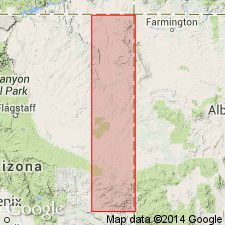
- Usage in publication:
-
- White House Member
- Modifications:
-
- Named
- Dominant lithology:
-
- Sandstone
- AAPG geologic province:
-
- Black Mesa basin
Summary:
Named as one of five members of De Chelly [sic] Sandstone for White House Trail in Canyon de Chelly National Monument, Apache Co, AZ in the Black Mesa basin. Type section is at White House Trail. Consists of large-scale, high-angle, cross-stratified sandstone that forms canyon walls. Of eolian origin. Has some ripple marks and animal tracks. Flat truncation surfaces give member a layered appearance. In some places, thin, poorly sorted, calcareous silty sandstones overlie such surfaces. These silty sandstones may have been deposited in shallow ephemeral water caused by a high water table. Is 570 feet thick in type area [not clearly designated]. Absent south of Oak Springs Cliffs. Is 45 feet thick at Oak Springs Cliffs, 200 feet thick at Bonito Canyon, 502 feet thick at Nazlini Canyon, and 570 feet thick in Canyon de Chelly. Overlies Oak Springs Cliffs Member (new) of De Chelly. and locally overlies Hunters Point Member (new) of De Chelly. Underlies Black Creek Member (new) of De Chelly. Permian age.
Source: GNU records (USGS DDS-6; Denver GNULEX).
For more information, please contact Nancy Stamm, Geologic Names Committee Secretary.
Asterisk (*) indicates published by U.S. Geological Survey authors.
"No current usage" (†) implies that a name has been abandoned or has fallen into disuse. Former usage and, if known, replacement name given in parentheses ( ).
Slash (/) indicates name conflicts with nomenclatural guidelines (CSN, 1933; ACSN, 1961, 1970; NACSN, 1983, 2005, 2021). May be explained within brackets ([ ]).

